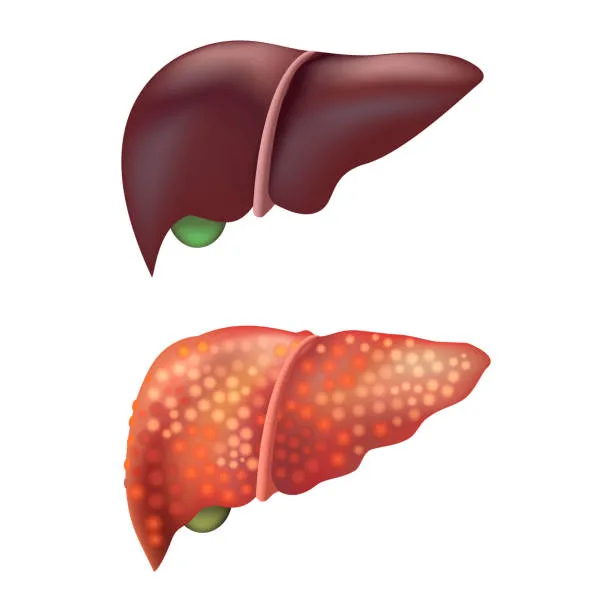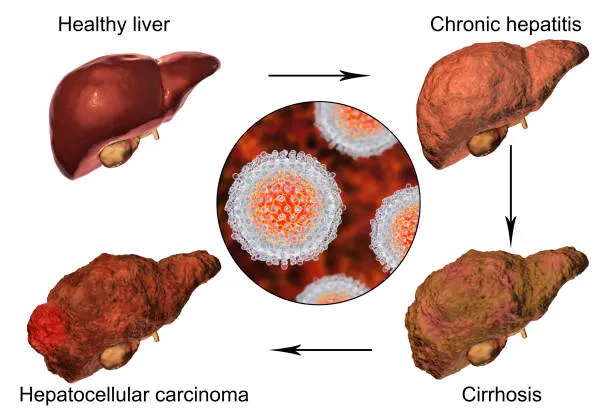
Image Source
The liver is the largest organ found in the body, and serves many vital functions. It is primarily responsible for processing nutrients, vitamins, and minerals. However, it’s also responsible for filtering toxins and chemicals, as well as breaking down alcohol. When too much alcohol is consumed regularly for extended periods of time, it can lead to a weakened liver with several complications. Working with the digestive system, the liver processes nutrients from food and turns them into other substances that can be used by the body. The liver also plays a key role in breaking down alcohol so that it can be removed from the body rather than continuing to circulate in it. When someone drinks too much alcohol too often, this may negatively impact their liver and what they are able Alcoholic Liver Disease (ALD) can develop as a result of chronic alcohol use. The effects of alcohol on the liver include a variety of different diseases and conditions depending on how intense your drinking habits are.
Reference Source
How Alcohol Affects the Liver
The liver is responsible for breaking down alcohol into water and carbon dioxide. However, when the liver is forced to metabolize too much of an alcohol-containing substance, it can be damaged over time. This can lead to scarring on the liver and reduced function over time. The amount of alcohol a person consumes can vary greatly, and this also impacts how it affects the liver. Below are some of the ways that alcohol can affect the liver:
Reduced Blood Flow to the Liver: When alcohol enters the bloodstream, it reduces blood flow to the liver. This means that the liver is receiving less blood so it can’t function at its full capacity. This occurs because alcohol blocks receptors that are responsible for regulating blood flow.
Altered Metabolism: The way the liver breaks down alcohol is also impacted by the amount of alcohol consumed. As alcohol amounts are increased, it slows down the metabolism of the liver. This means that it takes longer for the liver to break down and metabolize alcohol. As a result, it takes longer for the body to break down alcohol.
Increased Bile Production: The liver produces bile, which is important for processing fat. It also aids in the breakdown of cholesterol. Alcohol consumption, however, increases bile production. This means that the liver is focused on producing more bile, not on processing alcohol.
Fatty Liver Disease
There is a difference between fatty liver and alcoholic liver disease. Fatty liver is a non-alcoholic liver disease that occurs when a person has a high amount of fat in their liver. This often happens when a person is overweight and experiences insulin resistance, as well as type 2 diabetes. Fatty liver is sometimes seen in people who drink too much alcohol or use certain medications like diuretics. However, most people with fatty liver don’t have any symptoms. It’s sometimes found during routine blood tests. Doctors usually recommend further tests if there is an abnormal amount of fat in the liver. Fatty liver is not a serious condition, and it doesn’t always cause symptoms. If left untreated, however, it can lead to serious complications, including cirrhosis.
Reference Source
Alcoholic Steatohepatitis (ASH)
Alcoholic steatohepatitis (ASH) is a type of liver disease that results from long-term heavy drinking. It is closely related to non-alcoholic fatty liver disease. ASH may include some scarring of the liver and may lead to liver failure. It is a serious and potentially fatal condition. ASH is more likely to occur in people who drink large amounts of alcohol and don’t eat a healthy diet. Usually the symptoms of ASH will go away if a person quits drinking. This usually takes one to two years after quitting.

Image Source
Acute alcoholic hepatitis
Acute alcoholic hepatitis (AAH) is another serious disease that can result from heavy alcohol use. AAH is a sudden inflammation of the liver. It is also referred to as “fulminant hepatitis” since it can develop quickly, sometimes within just a few days. AAH is more likely to occur in people who drink large amounts of alcohol and don’t eat a healthy diet.
Cirrhosis
Cirrhosis is a chronic disease that slowly damages the liver. It is caused by an injury to the liver that leads to scarring. In some cases, alcohol is the cause of this scarring. Cirrhosis can be fatal if left untreated, and it can significantly reduce the quality of life. Cirrhosis is more likely to occur in people who drink large amounts of alcohol and don’t eat a healthy diet.
Reference Source
Reference:
https://en.m.wikipedia.org/wiki/Alcoholic_liver_disease
https://www.nhs.uk/conditions/alcohol-related-liver-disease-arld/
https://www.nhs.uk/conditions/non-alcoholic-fatty-liver-disease/#:~:text=Non%2Dalcoholic%20fatty%20liver%20disease%20
